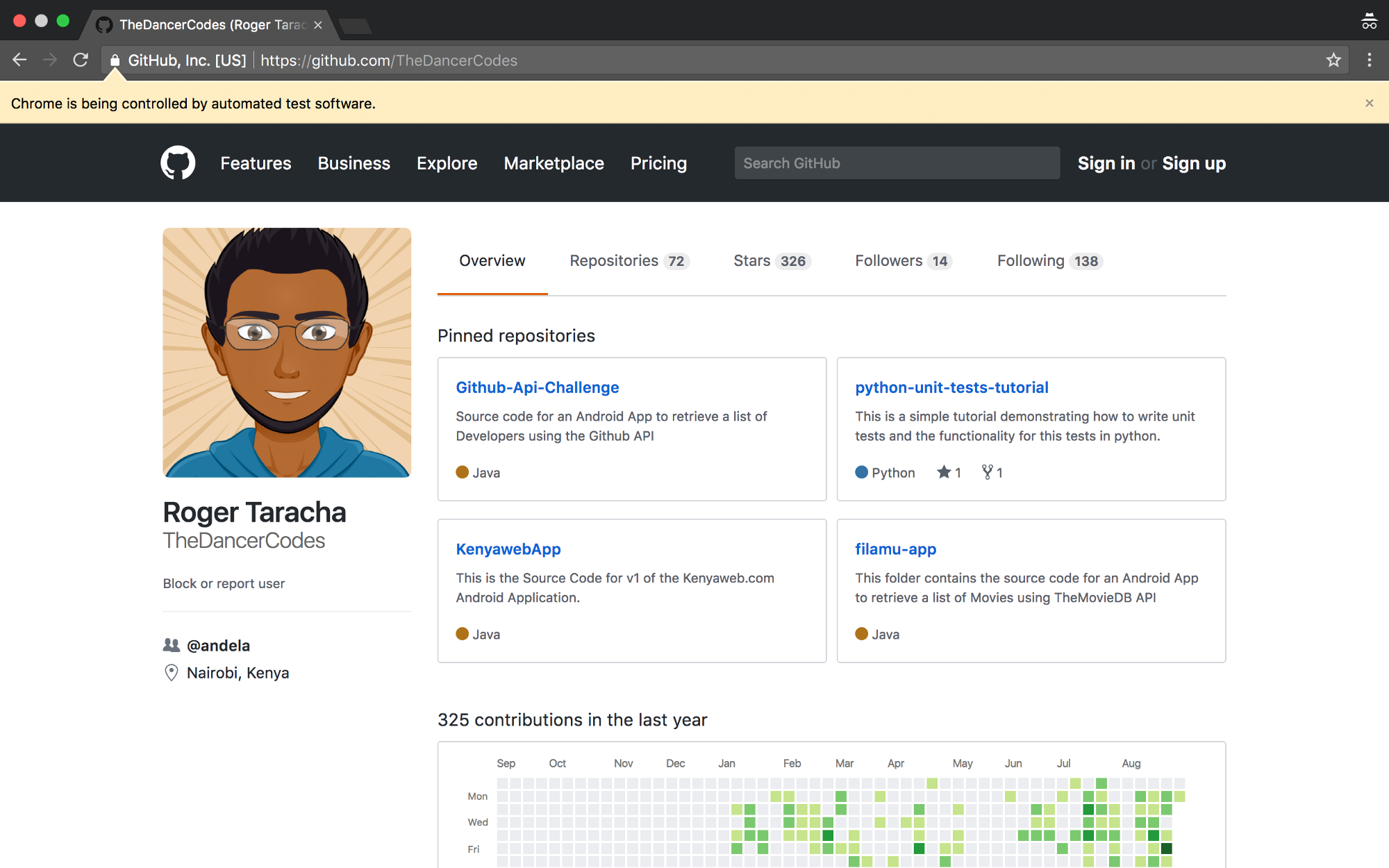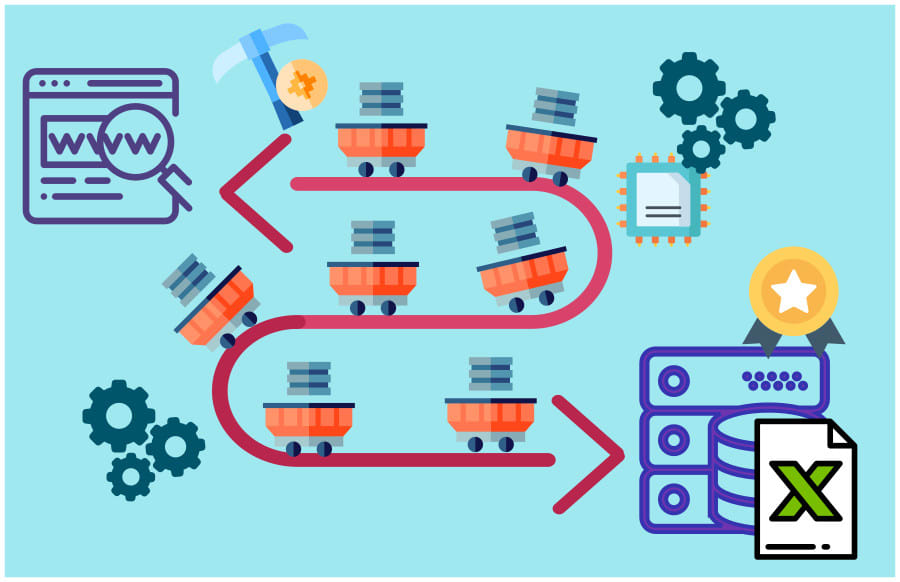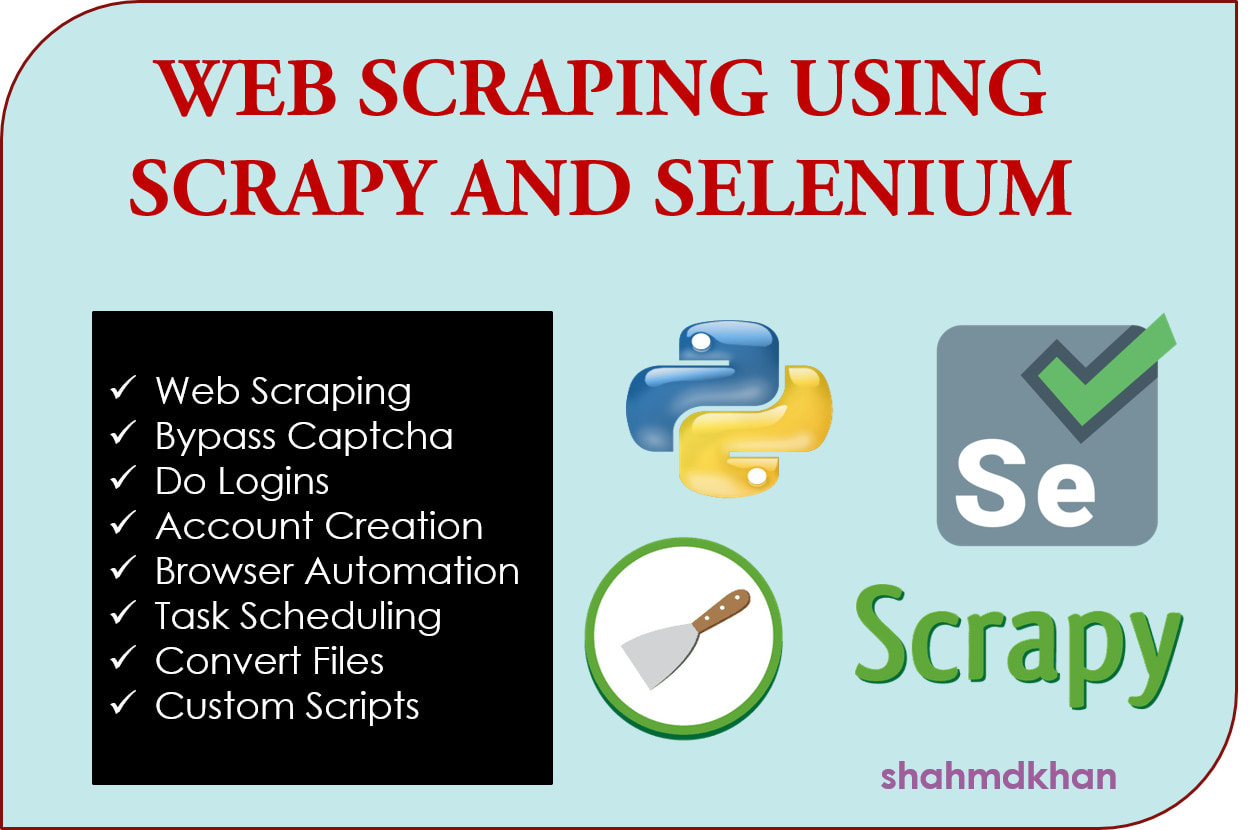In the last tutorial we learned how to leverage the Scrapy framework to solve common web scraping problems.Today we are going to take a look at Selenium (with Python ❤️ ) in a step-by-step tutorial.
Jul 15, 2020 Selenium is a great tool for web scraping, especially when learning the basics. But, depending on your goals, it is sometimes easier to choose an already-built tool that does web scraping for you. Building your own scraper is a long and resource-costly procedure that might not be worth the time and effort. Navigating to a URL with Selenium. Now we’re ready to write some code. Let’s start off by creating an instance of a Chrome WebDriver (the driver is an IDisposable object, so it should be instantiated in a using statement) and navigating to a URL (I’ll be using this scraping test site).Additionally, let’s wait for 5 seconds before the browser is closed. Oct 26, 2020 Webdriver is the heart of Selenium Python. It can be used to perform various operations like automating testing, perform operations on-webpage elements like close, back, getcookie, getscreenshotaspng, getwindowsize to name a few. Jan 05, 2021 In this article, we’re going to talk about how to perform web scraping with python, using Selenium in the Python programming language. Web scraping, also called web data extraction, refers to the technique of harvesting data from a web page through leveraging the patterns in the page’s underlying code. Oct 03, 2018 What is web-scraping? Web scraping is a technique for extracting information from the internet automatically using a software that simulates human web surfing. How is web-scraping useful? Web scraping helps us extract large volumes of data ab o ut customers, products, people, stock markets, etc. It is usually difficult to get this kind of.
Selenium refers to a number of different open-source projects used for browser automation. It supports bindings for all major programming languages, including our favorite language: Python.
The Selenium API uses the WebDriver protocol to control a web browser, like Chrome, Firefox or Safari. The browser can run either localy or remotely.
At the beginning of the project (almost 20 years ago!) it was mostly used for cross-browser, end-to-end testing (acceptance tests).
Now it is still used for testing, but it is also used as a general browser automation platform. And of course, it us used for web scraping!
Selenium is useful when you have to perform an action on a website such as:
- Clicking on buttons
- Filling forms
- Scrolling
- Taking a screenshot
It is also useful for executing Javascript code. Let's say that you want to scrape a Single Page Application. Plus you haven't found an easy way to directly call the underlying APIs. In this case, Selenium might be what you need.
Installation

We will use Chrome in our example, so make sure you have it installed on your local machine:
seleniumpackage
To install the Selenium package, as always, I recommend that you create a virtual environment (for example using virtualenv) and then:
Quickstart
Once you have downloaded both Chrome and Chromedriver and installed the Selenium package, you should be ready to start the browser:
This will launch Chrome in headfull mode (like regular Chrome, which is controlled by your Python code).You should see a message stating that the browser is controlled by automated software.
To run Chrome in headless mode (without any graphical user interface), you can run it on a server. See the following example:
The driver.page_source will return the full page HTML code.

Here are two other interesting WebDriver properties:
driver.titlegets the page's titledriver.current_urlgets the current URL (this can be useful when there are redirections on the website and you need the final URL)
Locating Elements
Locating data on a website is one of the main use cases for Selenium, either for a test suite (making sure that a specific element is present/absent on the page) or to extract data and save it for further analysis (web scraping).
There are many methods available in the Selenium API to select elements on the page. You can use:
- Tag name
- Class name
- IDs
- XPath
- CSS selectors
We recently published an article explaining XPath. Don't hesitate to take a look if you aren't familiar with XPath.
As usual, the easiest way to locate an element is to open your Chrome dev tools and inspect the element that you need.A cool shortcut for this is to highlight the element you want with your mouse and then press Ctrl + Shift + C or on macOS Cmd + Shift + C instead of having to right click + inspect each time:
find_element
There are many ways to locate an element in selenium.Let's say that we want to locate the h1 tag in this HTML:
All these methods also have find_elements (note the plural) to return a list of elements.
For example, to get all anchors on a page, use the following:
Some elements aren't easily accessible with an ID or a simple class, and that's when you need an XPath expression. You also might have multiple elements with the same class (the ID is supposed to be unique).
XPath is my favorite way of locating elements on a web page. It's a powerful way to extract any element on a page, based on it's absolute position on the DOM, or relative to another element.
WebElement
A WebElement is a Selenium object representing an HTML element.
There are many actions that you can perform on those HTML elements, here are the most useful:
- Accessing the text of the element with the property
element.text - Clicking on the element with
element.click() - Accessing an attribute with
element.get_attribute('class') - Sending text to an input with:
element.send_keys('mypassword')
There are some other interesting methods like is_displayed(). This returns True if an element is visible to the user.
It can be interesting to avoid honeypots (like filling hidden inputs).
Honeypots are mechanisms used by website owners to detect bots. For example, if an HTML input has the attribute type=hidden like this:
This input value is supposed to be blank. If a bot is visiting a page and fills all of the inputs on a form with random value, it will also fill the hidden input. A legitimate user would never fill the hidden input value, because it is not rendered by the browser.
That's a classic honeypot.
Full example
Where do you weebly? show us and win an ipad!. Here is a full example using Selenium API methods we just covered.
We are going to log into Hacker News:
In our example, authenticating to Hacker News is not really useful on its own. However, you could imagine creating a bot to automatically post a link to your latest blog post.
In order to authenticate we need to:
- Go to the login page using
driver.get() - Select the username input using
driver.find_element_by_*and thenelement.send_keys()to send text to the input - Follow the same process with the password input
- Click on the login button using
element.click()
Should be easy right? Let's see the code:
Easy, right? Now there is one important thing that is missing here. How do we know if we are logged in?
We could try a couple of things:
- Check for an error message (like “Wrong password”)
- Check for one element on the page that is only displayed once logged in.
So, we're going to check for the logout button. The logout button has the ID “logout” (easy)!
We can't just check if the element is None because all of the find_element_by_* raise an exception if the element is not found in the DOM.So we have to use a try/except block and catch the NoSuchElementException exception:
Web Scraping With Python
Taking a screenshot
We could easily take a screenshot using:
Note that a lot of things can go wrong when you take a screenshot with Selenium. First, you have to make sure that the window size is set correctly.Then, you need to make sure that every asynchronous HTTP call made by the frontend Javascript code has finished, and that the page is fully rendered.
In our Hacker News case it's simple and we don't have to worry about these issues.
Waiting for an element to be present
Dealing with a website that uses lots of Javascript to render its content can be tricky. These days, more and more sites are using frameworks like Angular, React and Vue.js for their front-end. These front-end frameworks are complicated to deal with because they fire a lot of AJAX calls.
If we had to worry about an asynchronous HTTP call (or many) to an API, there are two ways to solve this:
- Use a
time.sleep(ARBITRARY_TIME)before taking the screenshot. - Use a
WebDriverWaitobject.
If you use a time.sleep() you will probably use an arbitrary value. The problem is, you're either waiting for too long or not enough.Also the website can load slowly on your local wifi internet connection, but will be 10 times faster on your cloud server.With the WebDriverWait method you will wait the exact amount of time necessary for your element/data to be loaded.
This will wait five seconds for an element located by the ID “mySuperId” to be loaded.There are many other interesting expected conditions like:
element_to_be_clickabletext_to_be_present_in_elementelement_to_be_clickable

You can find more information about this in the Selenium documentation
Executing Javascript
Sometimes, you may need to execute some Javascript on the page. For example, let's say you want to take a screenshot of some information, but you first need to scroll a bit to see it.You can easily do this with Selenium:
Conclusion
I hope you enjoyed this blog post! You should now have a good understanding of how the Selenium API works in Python. If you want to know more about how to scrape the web with Python don't hesitate to take a look at our general Python web scraping guide.
Selenium is often necessary to extract data from websites using lots of Javascript. The problem is that running lots of Selenium/Headless Chrome instances at scale is hard. This is one of the things we solve with ScrapingBee, our web scraping API
Web Scraping Selenium Vba
Selenium is also an excellent tool to automate almost anything on the web.

If you perform repetitive tasks like filling forms or checking information behind a login form where the website doesn't have an API, it's maybe* a good idea to automate it with Selenium,just don't forget this xkcd:
Selenium Web Scraping Tutorial
